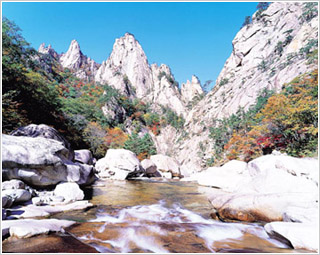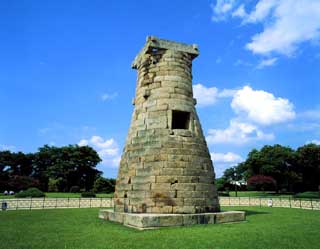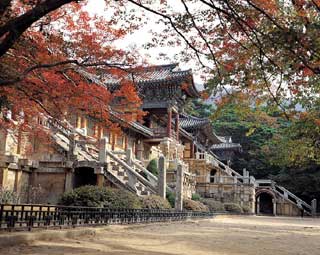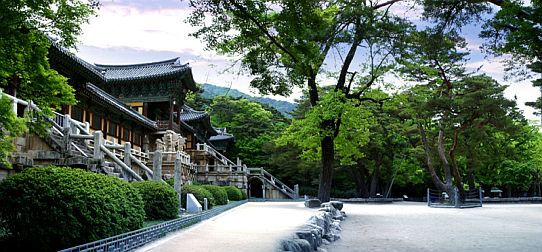Sharp Travel & Tours Inc.
Contact Info
Telephone - 847.759.8813
Toll Free - 1.888.To.Sharp
Email - sharptour@hotmail.com
Popular Destinations
STANDARD GROUP TOURS
DAILY EXCURSIONS
AMT RECOMMENDATIONS
Large ancient tombs of kings and noblemen of the Silla Dynasty can be seen around Gyeongju at the Daereung-won Tumuli Park. There are twenty-three large tombs located here; the most famous ancient tomb being Cheonmachong and Hwangnamdaechong. In an excavation of the area in the 1970's, Cheonmachong was discovered with a painting of mounted horse. This painting is the only discovered painting from the Silla Era. You can also view the inside of Cheonmachong. There are 11,526 remains and crowns of the king inside the tomb demonstrating the lavish lifestyle of the king.
Seokguram, located on Mt.Tohamsan, is the representative stone temple of Korea. The official name of Seokguram, National Treasure No. 24, is Seokguram Seokgul. Designated as World Cultural Heritage Site by UNESCO in 1995, it is an artificial stone temple made of granites. The construction started with Kim Dae-Seong (700~774) in 751 during the reign of King Gyeong-Deok (742~765) of the Silla Dynasty (57 B.C.~A.D. 935) and it was finished in 774, after 24 years, during the reign of King Hye-Gong (765~780).

The name 'Bulguksa' was kept through numerous renovations of the temple from the Goryeo Dynasty (918~1392) to the Joseon Dynasty (1392~1910). But during the Imjinwaeran War (the war provoked by Japan's invasion, 1592~1598) the wooden building was burned, 819 years after first being established.
From 1604, during Joseon Dynasty (King Seon-Jo's 37th year) the reconstruction started again and was renovated approximately 40 times till 1805, to the reign of King Sun-Jo (1790~1834). But the temple still suffered many robberies and damage afterwards.
In 1969, the Bulguksa Temple Restoration Committee was formed and Mulseoljeon, Gwaneumjeon, Birojeon, Gyeongru and Hoerang, which were merely left as grounds of the original buildings, were rebuilt in 1973. Other old or broken sites such as Daewungjeon, Geukrakjeon, Beomyeongru and Jahamun were repaired.
The Bulguksa Temple of today has many cultural relics preserved within it, such as Dabo-tap (National Treasure No.20), Sukga-tap (National Treasure No.21) Yeonhwa-gyo* Chilbo-gyo (National Treasure No.22), Cheongun-gyo*Baekun-gyo (National Treasure No.23) Golden Seated Vairocana Buddhist Figure (National Treasure No.26), Golden Seated Amita Figure (National Treasure No.27) and Sari-tap (National Treasure No.61) among others.
The Dabotap (Many Treasure Pagoda) and Seokgatap (Sakyamuni Pagoda) are major pagodas of Korea. Designated as Korean National Treasures in 1962, the two pagodas, each measuring 10.4 meters (Dabotap) and 8.2 meters (Seokgatap), stand on the east and west sides of the yard separating Daeungjeon (the hall housing the Shakyamuni Buddha) and Jahamun (Mauve Mist Gate).
The three-story Seokgatap, on the east, has two stereobates and is in traditional Korean style. Dabotap is an octagonal pagoda standing on a cruciform base with stone staircases on all four sides and a railing. Given its superior craftsmanship, it is difficult to imagine that it was constructed of stone. Unlike Seokgatap, Dabotap has survived the passage of time with its original structure still intact. Both outstanding examples of 8th-century Unified Silla architecture, the two pagodas skillfully balance the square, octagonal, and circle in one design.
Moving between Daeungjeon and Geungnakjeon (both prayer halls), visitors cross the Cheongungyo (Blue Cloud Bridge) and Baegungyo (White Cloud Bridge) to the east, and Yeonhwagyo (Lotus Flower Bridge) and Chilbogyo (Seven Treasure Bridge) to the west. Cheongungyo and Baegungyo are actually stairways, not bridges. The lower portion, Cheongungyo, has 17 steps and the upper part, Baegungyo, has 16. These steps lead to Jahamun, which is the gate to Daeungjeon (Sakyamuni Buddha Hall). These bridge-like stairways symbolically connect the mundane world below and the world of Buddha above. Some say that they symbolize life of a young man and of an old man. The construction of the stairway in the shape of a bridge is unique, and these national treasures are the only such structures that have survived intact from the Silla era.
To the west, an 18-step stone staircase leads to Anyangmun (Pure Land Gate). The lower ten-step portion of that staircase is called Yeonhwagyo, while the upper part with eight steps is Chilbogyo. It is said that only those who reached enlightenment could use these stairs. Both structures are smaller than Cheongungyo and Baegungyo, but the design and structure are quite similar. Most of the lotus-blossom carvings that beautified Yeonghwagyo have been lost over time, and the passage is currently restricted to visitors. These are major historical components of Bulguksa Temple, as well as National Treasures.
As one faces Cheongungyo and Baegungyo, Beomyeongnu (Pavilion of Mount Meru) is on the left. Originally built in 751 CE, the pavilion was damaged in 1593 by the Japanese during the Imjin War and restored in two separate projects during the Joseon Dynasty. A restoration project undertaken in 1973 resulted in the current structure, which is smaller than the original. The pavilion has a wide lower portion, a narrower middle above the stone pillars, and an upper portion as wide as the lower portion. Particularly unique are the stacked pillars, using 8 differently shaped stones, and their placement, facing each of the four directions. Today, the pavilion houses a drum atop a turtle structure.
ANNUAL FESTIVALS
DAEREUNGWON TOMBS
SEOKGURAM
BULGUKSA TEMPLE

GYEONGJU ATTRACTIONS
Cheomseongdae is the oldest existing astronomical observatory in Asia.
Constructed during the reign of Queen Seon-deok (632-647), it was used for observing the stars in order to forecast the weather. This stone structure is a beautiful combination of straight lines and curves, and was designated as National Treasure No.31 on December 20th, 1962.
Cheomseongdae was built in a cylinder shape with stones 30cm in diameter. 362 stones were piled up to make 27 levels. 4.16m up from the bottom there is a 1㎡ square entrance and a space to hang a ladder under it.
CHEOMSEONGDAE

Seokguram is known to have been built with Bulguksa Temple. According to the history book Samgukyusa of the Goryeo Dynasty (the country that unified the Korean peninsula at the end of the Silla Dynasty, 918~1392), Kim Dae-Seong had built Bulguksa for the parents who were alive, and Seokguram for the parents of his former life.
Seokguram is an artificial stone temple made of granites, and is located on the eastern peak of Mt. Toham (745m sea level). Inside the round-shaped main hall, there are the Bonjon Statue, Bodhi-sattva and his disciples. Seokguram was built to preserve these statues. The Bonjon figure wearing a generous smile is seated on the stage engraved with lotus flower design. The rounded ceiling looks like a half-moon or a bow and has a lotus flower decorated cover on it. As the sunrise from this spot is so beautiful, many people climb the mountain at daybreak.


Another tourist attraction is Hwangnamdaechong, which is the largest ancient tomb. It houses the bodies of both the king and queen and has over 30 thousand relics and gold accessories. The unique thing about Hwangnamdaechong is that the queen's tomb has more luxurious accessories. From that researchers have concluded that even the queen can have a high social position before marriage. You can feel the ancient culture of Korea 1,500 years ago when visiting these tombs.

Bulguksa Temple is the representative relic of Gyeongju and was designated as a World Cultural Asset by UNESCO in 1995. The beauty of the temple itself and the artistic touch of the stone relics are known throughout the world.
Bulguksa Temple was built in 528 during the Silla Dynasty, in the 15th year of King Beop-Heung's reign (514~540). It was called Hwaeom Bulguksa Temple or Beopryusa Temple back then. In 751, under King Gyeong-Deok (reign 742∼765), Kim Dae-Seong (700~774) started rebuilding the temple and finished in 774, under King Hye-Gong (reign 765~780). After 17 years of construction, the name 'Bulguksa' was finally given to the temple.
The inside is filled with soil up to the 12th level, and the 19th, 20th, 25th, and 26th levels all have long rocks hanging on two areas, shaped as the Chinese letter '井' (jeong).
It stands 9.17m high and the base stone on each side measures 5.35m.
The Vernal Equinox, Autumnal Equinox, Winter Solstice, Summer Solstice and the 24 solar terms (also known as the astronomical solar year) were determined by the observation of stars. The pavilion stone is believed to have been used as a standard of deciding directions, north, south, east and west. The 362 stones used to build Cheomseongdae represented the 362 days in a lunar year.
Gyeongju National Museum is deep in tradition, with a history of about 90 years. Representing Gyeongju, which used to be the capital of Silla (BC57~AD935), the museum is where you can view the cultural history of Gyeongju district. The exhibit hall is divided into 4 large parts: the Main hall, Annex I, Annex II, and the Outdoor Exhibit Area (Museum Grounds). In the Main Hall you can see earthenware, and in the Arts and Crafts room you can see various artwork and craftwork. Gukeun Memorial Hall exhibits 666 artifacts, which are the personal collection of Dr. Lee Yang-Seon, donated here for preservation.
GYEONGJU NATIONAL MUSEUM

Artifacts from the great tombs still left in the city of Gyeongju are exhibited in Annex I, the Gobun Gallery. There are many glittering accessories, such as golden crowns, crown ornaments, belts, earrings etc. You can experience the superb artistry from the Silla Period through these artifacts. Approximately 30,000 artifacts were excavated from Anapji Pond, the most significant of which are exhibited in Annex 2, the Anapji Gallery. The other galleries exhibit household goods. The various types of items show the life in the Royal Court during the Silla Period. After the galleries, you can move on to the Outdoor Exhibit Area, which is the Museum Grounds. The King Seongdeok’s Bell located there, is the most renowned bell of Buddhist temples. You cannot help but feel solemn as you watch the relic. There are also various artifacts from royal palaces and temples exhibited here. Buddhist sculptures make up a majority of the stone artifacts. If you are a traveler interested in Buddhism or the magnificent culture of royal palaces, this is a place you do not want to miss.
POPULAR DESTINATIONS
© 2008 Sharp Travel and Tours Inc.
 | ||||||
